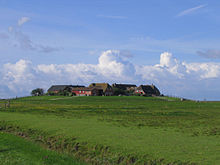Artificial dwelling hill: Difference between revisions
No edit summary |
m better picture |
||
| Line 1: | Line 1: | ||
:''For other uses, see [[Terp (disambiguation)]].'' |
:''For other uses, see [[Terp (disambiguation)]].'' |
||
[[Image: |
[[Image:Hallig Hooge 2005.jpg|thumb|Terpen on hallig Hooge]] |
||
'''Terp''' (plural ''terpen'') is a term for a hillock, mound or knoll used for refuge from [[high tide]] and [[flood]]s. ''Terp'' means "village" in [[Frisian language|Frisian]]: compare [[English language|English]] "-[[thorp]]e" "Dorp" in Dutch in placenames. Historical Frisian settlements were built on artificial terpen measuring up to 15 m in height to be safe from the floods in periods of rising sea levels. The first terp-building period dates from [[500 BC]], the second from [[200 BC]] to 50 BC. In the mid 3rd century, the rise of sea level was so dramatic that the [[clay district]] was deserted, and settlers returned only around AD 400. A third terp-building period dates from AD [[700]] ([[Old Frisian]] times). This ended with the coming of the [[Dike (construction)|dike]] somewhere around 1200. During the 18th and 19th centuries many terps were destroyed to use the fertile soil they contained to fertilize farm fields. The largest terp, seen on the picture to the right, is still preserved. |
'''Terp''' (plural ''terpen'') is a term for a hillock, mound or knoll used for refuge from [[high tide]] and [[flood]]s. ''Terp'' means "village" in [[Frisian language|Frisian]]: compare [[English language|English]] "-[[thorp]]e" "Dorp" in Dutch in placenames. Historical Frisian settlements were built on artificial terpen measuring up to 15 m in height to be safe from the floods in periods of rising sea levels. The first terp-building period dates from [[500 BC]], the second from [[200 BC]] to 50 BC. In the mid 3rd century, the rise of sea level was so dramatic that the [[clay district]] was deserted, and settlers returned only around AD 400. A third terp-building period dates from AD [[700]] ([[Old Frisian]] times). This ended with the coming of the [[Dike (construction)|dike]] somewhere around 1200. During the 18th and 19th centuries many terps were destroyed to use the fertile soil they contained to fertilize farm fields. The largest terp, seen on the picture to the right, is still preserved. |
||
Revision as of 11:18, 18 January 2007
- For other uses, see Terp (disambiguation).

Terp (plural terpen) is a term for a hillock, mound or knoll used for refuge from high tide and floods. Terp means "village" in Frisian: compare English "-thorpe" "Dorp" in Dutch in placenames. Historical Frisian settlements were built on artificial terpen measuring up to 15 m in height to be safe from the floods in periods of rising sea levels. The first terp-building period dates from 500 BC, the second from 200 BC to 50 BC. In the mid 3rd century, the rise of sea level was so dramatic that the clay district was deserted, and settlers returned only around AD 400. A third terp-building period dates from AD 700 (Old Frisian times). This ended with the coming of the dike somewhere around 1200. During the 18th and 19th centuries many terps were destroyed to use the fertile soil they contained to fertilize farm fields. The largest terp, seen on the picture to the right, is still preserved.
Another Dutch word for "terp" is wierde.
Many villages in the Dutch provinces of Friesland and Groningen still have names which are related to these words, showing that the village was built on a terp.
Examples of terpen can be found in:
- Aalsum
- Eesinge
